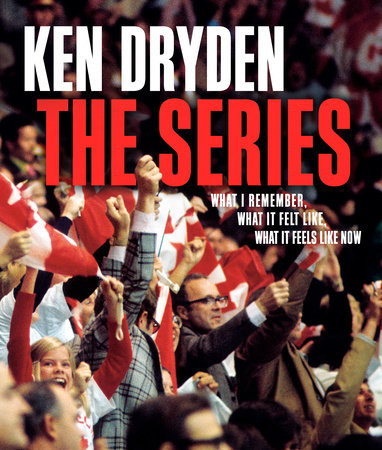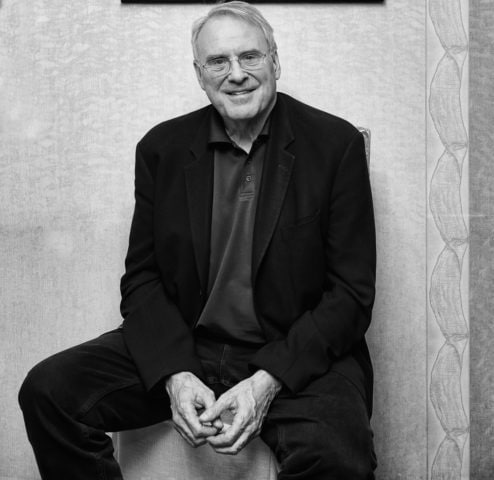Move over, Dos Equis commercial actor, because former Montreal Canadiens goalie Ken Dryden just might be the most interesting man in the world. In addition to his brilliant hockey career — Dryden won six Stanley Cups, was inducted into the Hockey Hall of Fame, and was ranked number 26 in the Hockey News list of the 100 greatest players of all time — the 75-year-old was also a member of the Canadian Parliament, was Canada’s Minister of Social Development, and was named an Officer of the Order of Canada, one of that nation’s highest honors.
If that’s not enough to convince you, Dryden is also a published author. He has nine books to his credit, including The Game, a first-hand account of one week late in the 1978-79 hockey season. The Game is widely heralded as one of the best hockey books ever written and was number nine on the Sports Illustrated list of The Top 100 Sports Books of All Time.
Related: Ken Dryden’s “The Game,” Still a Classic
Dryden’s new book, The Series: What I Remember, What It Felt Like, What It Feels Like Now, is a personal memoir of the author’s experience playing for Team Canada in a high-intensity series with the Soviet Union in 1972, the winner of which would be crowned world champion.
The Elusive World Championship
The book, a coffee table-format pictorial rife with photos from the events Dryden describes, opens with the author’s recollection of Russian dominance on the world stage of hockey in the 1960s. International play, including the Olympics at that time, forbade professionals from participating.
“It was so frustrating,” Dryden writes. “So infuriating. We had Gordie Howe, we had Bobby Hull, Frank Mahovlich, Stan Mikita, Glenn Hall. We were the best in the world, so undeniably the best. And everyone else knew it — in Canada, in the United States, Sweden, Czechoslovakia, Finland, even in the Soviet Union — anywhere hockey was played. They had to know.”

Then in 1972, the rules changed; professionals were suddenly allowed to play. Dryden, who had just finished his second season with the Canadiens, was named to the team that would compete in an eight-game series against the Soviet Union, which would become known as the Summit Series. He was a deserving selection. During his first 16 months in the league, Dryden had won the Stanley Cup, the Conn Smythe Trophy (Stanley Cup Playoffs MVP), and the Calder Trophy (Rookie of the Year). He’s the only player in NHL history to win the Conn-Smythe before winning the Calder.
“Dear N.H.L.P.A Member,” began the letter Dryden received, which is reproduced in the book. “You are hereby notified that you have been chosen to represent Canada against Russia in the September Series.”
Canada’s Best
With professionals, including NHL players, cleared to participate, Canada was going to assemble a team of true all-stars.
“All of Canada’s best players were there, except Bobby Orr, who was injured, and Bobby Hull, who had signed with the Winnipeg Jets of the NHL rival World Hockey Association. All of the NHL’s top scorers, top goalies, every member of the league’s first and second all-star teams…”
The team, and by extension, the nation went into the series against the Soviets with confidence that bordered on arrogance. “The reporters yelled out their predictions. They, too, told us what we already knew — this would be a dominant, smashing, defining victory for Canada, likely eight straight. Talk on the street, every street in the country, turned to a loud buzz.”
The Symbolic Face-off
The year 1972 was the height of the Cold War. The Soviet Union had invaded Czechoslovakia only four years earlier, the Space Race was in high gear, and the Cuban Missile Crisis, ten years in the past, was still fresh in the minds of North Americans.
“Phil Esposito, the league’s great goal scorer, thirty years old, veteran of more than six hundred NHL games, positioned himself for the ceremonial faceoff at centre ice. A ritual moment, nothing more: the honoured person—in this case, [Canadian Prime Minister Pierre] Trudeau—dropping the puck; the captain of the home team—in this case, Esposito—moving his stick gently forward, then, with the puck on his stick, gently back, his opponent remaining motionless, then Esposito, as the home team captain, picking up the puck and handing it to the honouree. Instead, Esposito flashed his stick forward, whipped the puck back to his teammates and raised his arm in triumph “I had to win that draw,” he said later. This was not a ceremonial faceoff. This was a symbolic faceoff.”
Canadian vs. Russian Hockey
With the pomp and circumstance of the pregame festivities over, Canada did what everyone expected and bolted out of the starting gate with a vengeance. The home team scored two goals in the first six minutes of the game. The Montreal Forum, the host to game one of the series, was in a frenzy the likes of which few had ever experienced before.
And then, the inevitable. Both teams settled down, and the game shifted. Before anyone knew what had happened, the contest was over, and the Russians were 7-3 victors.
Dryden recounts the following days as the series traveled to Toronto, Winnipeg, Vancouver, and ultimately Moscow. He describes the ups and downs of both the team and his own emotional state. And in an analysis most hockey fans will find fascinating, he contrasts the two different styles of play, Canadian and Russian.
“Our game, the Canadian game, the only one that mattered, had always been ‘headman hockey.’ You get the puck, your teammates break forward, you get them the puck. Then, in the 1960s, ours became a power game, too, a slapshooters game.”

“Their game, the Russian game, was ‘possession hockey.’ You get the puck, your teammates break forward, sideways, backwards, wherever there’s open ice, and you get them the puck.”
Dryden describes how the influence of Russian (and European) hockey changed the game for the better in North America, how hockey has evolved as a result of those Soviet teams of the 1960s, and especially of the team the Canadians faced in the 1972 Summit Series.
If you’re not of a certain age and/or not from Canada, you may not know how the Summit Series ends, so I’ll offer no spoilers here. Dryden’s erudite and heartfelt retelling of the events of that summer is a must-read for students of the game, and the beautifully packaged book with its myriad color photos is the perfect gift for hockey fans everywhere.
